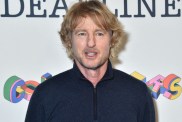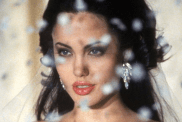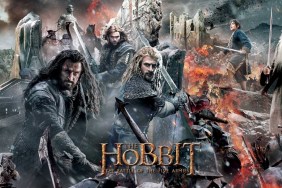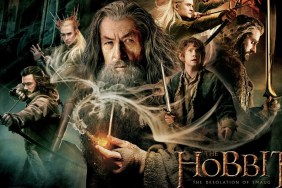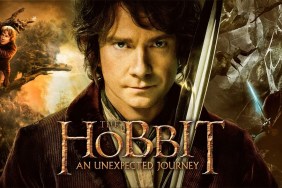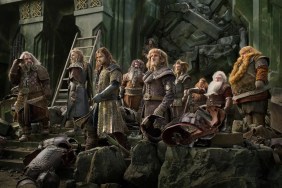
Rating: 8 out of 10
Cast:
Martin Freeman as Bilbo Baggins
Ian McKellen as Gandalf
Richard Armitage as Thorin Oakenshield
Luke Evans as Bard
Evangeline Lilly as Tauriel
Orlando Bloom as Legolas
Cate Blanchett as Galadriel
Hugo Weaving as Elrond
Christopher Lee as Saruman
Lee Pace as Thranduil
Benedict Cumberbatch as Smaug / Necromancer
Ryan Gage as Alfrid
Manu Bennett as Azog
Lawrence Makoare as Bolg
Aidan Turner as Kili
Dean O’Gorman as Fili
Billy Connolly as Dain
Sylvester McCoy as Radagast
Stephen Fry as Master of Laketown
James Nesbitt as Bofur
Graham McTavish as Dwalin
Ken Stott as Balin
Mikael Persbrandt as Beorn
Bret McKenzie as Lindir
Adam Brown as Ori
Jed Brophy as Nori
Mark Hadlow as Dori
William Kircher as Bifur
Stephen Hunter as Bombur
John Bell as BainJohn Callen as Oin
Peggy Nesbitt as Sigrid
Mary Nesbitt as Tilda
Mark Mitchinson as Braga
Simon London as Feren
Ian Holm as Old Bilbo
Directed by Peter Jackson
Story:
The climactic finale to Peter Jackson’s “The Hobbit” trilogy finds a number of factions of Middle-earth trying to get their hands on the gold within Smaug’s mountain lair, leading to a feud between the dwarves, the elves and the humans, all of whom are about to be descended upon by Sauron’s unstoppable army of orcs.
Analysis:
To say that the previous installment of Peter Jackson’s three-part adaptation of J.R.R. Tolkien’s “The Hobbit” left things open-ended would be an understatement, since literally all the characters were left in a place of peril. Fortunately, the main cliffhanger of the dragon Smaug leaving his cave after being holed up there for decades with the intention of attacking Lake Town is resolved in the first 15 minutes of the movie, leaving a void for others to take over the former dwarf’s mountain home.
Therein lies the main conflict at the center of the last act, because the dwarf king Thorin Oakenshield (Richard Armitage) made promises to the humans of Lake Town to give them their share of the gold within the mountain and after Smaug destroys their home, they can use the money. The elves have their own treasures lost to Smaug that they want back while Sauron wants the Lonely Mountain for its strategic location in his plans to dominate Middle-earth.
Luke Evans’ Bard is probably the real hero of the third film, trying to protect and save the people of Lake Town, and he makes a good counterpart to Thorin, who has been corrupted by the power and wealth he’s gained with Smaug’s departure. With so much focus on others, that leaves little room for Martin Freeman’s Bilbo Baggins i.e. that hobbit in the title who is caught in the middle of trying to calm everyone down before it leads to war.
As one might expect from the title, it does lead to a giant battle, but unlike “The Return of the King,” this isn’t just an hour of war between thousands of CG extras, but also a number of smaller one-on-one battles that offer a satisfying resolution to the loose ends created by the previous two films. The romance between she-elf Tauriel (Evangeline Lilly) and the dashing dwarf Kili (Aidan Turner) still provides the emotional core for the movie with the lovelorn Legolas (Orlando Bloom) providing some of the money shot action moments, but there aren’t nearly as many fun bits in the finale as in “The Desolation of Smaug,” although we do get a great sequence with Cate Blanchett, Hugo Weaving and Christopher Lee as their characters from “The Lord of the Rings.”
It’s likely that Tolkien purists will continue to be annoyed by the screen time given to characters that never existed in the original book and the amount of subplots that adds to the mix. Jackson’s decision to extend the single story into a trilogy ultimately does pay off, though.
As with the previous Tolkien films, there’s a certain amount of suspension of disbelief required, although if you’re already in for the penny, then you’re probably already in for the pound. If you accept an elf on a reindeer and a dwarf riding a large pig into battle, then surely you’ll buy the long-horned goats that magically appear to transport our dwarves into the final battle. Some of the larger CG creatures don’t offer the same visual gratification of those in “The Lord of the Rings,” as they seem to be fairly derivative by comparison.
As with “The Return of the King,” Jackson doesn’t seem to know quite where to end the film except to create a forced tie-in to the opening of “The Lord of the Rings,” driving home the point that this is very much meant to be a prequel to what is ultimately a far superior trilogy. (A less-than-veiled reference to Aragorn feels so forced and unnecessary, it will elicit more than a few groans.)
The Bottom Line:
Minor issues aside, this is another grand spectacle that does a fine job wrapping things up without offering nearly as many of the memorable moments of its predecessor… or “The Lord of the Rings” as a whole.
The Hobbit: The Battle of the Five Armies
-
The Hobbit: The Battle of the Five Armies

-
The Hobbit: The Battle of the Five Armies

-
The Hobbit: The Battle of the Five Armies

-
The Hobbit: The Battle of the Five Armies

-
The Hobbit: The Battle of the Five Armies

-
The Hobbit: The Battle of the Five Armies

-
The Hobbit: The Battle of the Five Armies

-
The Hobbit: The Battle of the Five Armies

-
The Hobbit: The Battle of the Five Armies

-
The Hobbit: The Battle of the Five Armies

-
The Hobbit: The Battle of the Five Armies

-
The Hobbit: The Battle of the Five Armies

-
The Hobbit: The Battle of the Five Armies

-
The Hobbit: The Battle of the Five Armies

-
The Hobbit: The Battle of the Five Armies

-
The Hobbit: The Battle of the Five Armies

-
The Hobbit: The Battle of the Five Armies

-
THE HOBBIT: THE BATTLE OF FIVE ARMIES

-
THE HOBBIT: THE BATTLE OF FIVE ARMIES

-
THE HOBBIT: THE BATTLE OF FIVE ARMIES

-
The Hobbit: The Battle of the Five Armies

-
The Hobbit: The Battle of the Five Armies

-
The Hobbit: The Battle of the Five Armies

-
The Hobbit: The Battle of the Five Armies

-
The Hobbit: The Battle of the Five Armies

-
The Hobbit: The Battle of the Five Armies

-
The Hobbit: The Battle of the Five Armies

-
The Hobbit: The Battle of the Five Armies

-
The Hobbit: The Battle of the Five Armies

-
The Hobbit: The Battle of the Five Armies

-
The Hobbit: The Battle of the Five Armies

-
The Hobbit: The Battle of the Five Armies

-
The Hobbit: The Battle of the Five Armies

-
The Hobbit: The Battle of the Five Armies

-
The Hobbit: The Battle of the Five Armies

-
The Hobbit: The Battle of the Five Armies

-
The Hobbit: The Battle of the Five Armies

-
The Hobbit: The Battle of the Five Armies

-
The Hobbit: The Battle of the Five Armies

-
The Hobbit: The Battle of the Five Armies

-
The Hobbit: The Battle of the Five Armies

-
The Hobbit: The Battle of the Five Armies

-
The Hobbit: The Battle of the Five Armies

-
The Hobbit: The Battle of the Five Armies

-
The Hobbit: The Battle of the Five Armies

-
The Hobbit: The Battle of the Five Armies

-
The Hobbit: The Battle of the Five Armies


